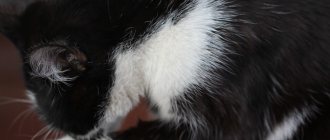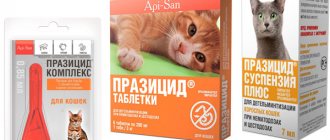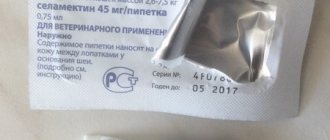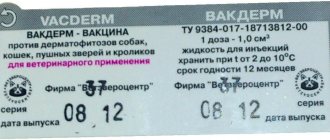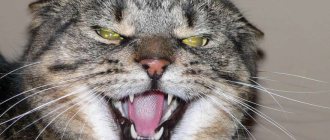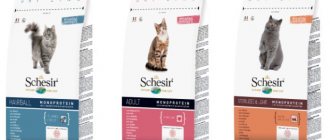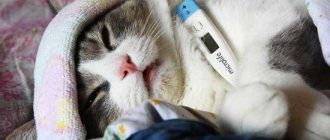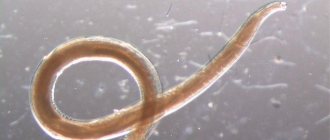Save the article:
Helminths sleep and see how to get to the body of their beloved cat, and the task of a responsible owner is to prevent this from happening. To rid the animal of malicious settlers or to take preventive measures, you can buy a prazicide for cats, which will do its job and save your pet’s health.
Release form and composition
global $ads_google;
//data-ad-slot=”2475549904″ $ads_google = empty($ads_google) ? false : true; ?> if ($ads_google == false) {?> $ads_google = true; ?> } ?> For the convenience of owners and their pets, the Prazicide complex for cats is produced in several versions. The manufacturer is Api-San, who made sure that the product can be used both for an adult cat and for a small kitten that has picked up helminths.
Drops Prazitsid complex
If it is convenient to use drops, then there is also an option for external use. They are dripped onto the withers, ticks, fleas and various ectoparasites also die.
The drops are light yellow and are sold in small polymer pipettes. Each contains its own dosage, as there is a prazicide complex for adult cats and for kittens. This determines the safety of using a product with the third hazard class.
Suspension plus
The action of the suspension is based on three active components: pyrantel pamoate, praziquantel and fenbendazole. The color of the solution is light yellow, the drug is sold in polymer bottles, dosed in the range of 5-15 ml.
There is a suspension developed for kittens, which is expressed in a change in the concentration of the active components.
Pills
Pyrantel pomoate and praziquantel are to blame for the effectiveness of the tablets. The tablets look familiar in white or white-gray with a round shape.
The tablets are small in size with a weight of 0.2 mg and are packaged in blisters, 6 pieces each.
Dosages
Dosages are calculated taking into account the age of pets and their weight category. If a suspension is chosen as a medicine, then 1 ml of the drug will be required per 1 kg of the cat’s body weight, which is very convenient to measure with a dispenser syringe.
Prazicide tablets are taken per 3 kg of cat weight - one tablet
Drops are also calculated by weight: if the cat weighs less than 5 kg, then you need to take 0.85 ml of the product, that is, one pipette. If this threshold is exceeded, 2 pipettes are already used, that is, 1.7 ml.
When is it contraindicated?
The use of Prazicide, according to the instructions, is contraindicated in the following cases:
- Individual intolerance to the components included in the suspension.
- Less than 3 weeks old.
- Presence of infectious diseases.
- The kitten is in a state of exhaustion.
- Recent recovery of the animal.
Prazicide should not be used simultaneously with drugs that contain cholyesterase and pasteurase inhibitors or its substitutes.
How does it work on parasites?
It doesn’t matter whether suspension, tablets or drops are used to treat a cat against parasites, but all of them will disrupt the transmission of nerve impulses, which in turn leads to paralysis and death of helminths.
Prazicide is a potent agent; its components are equally effective in killing eggs, larvae and adults.
Tablets and suspension perfectly destroy various parasites, as a result, nematodosis, cestodosis, mixed infestations are cured, and roundworms and tapeworms are easily treated.
The effect of the drops is even broader, because they kill not only entoparasites, but also ectoparasites located on the skin and fur of the animal.
Safety precautions for humans when in contact with the drug
Smoking, food and liquid intake by a person during treatment and prevention with Prazicide are unacceptable . After contact with the medicine (even if you only held a syringe or pipette), you must wash your hands thoroughly with warm water and soap. For 24 hours after applying the drops, it is forbidden to pet the cat and allow children near it. Empty drug packaging cannot be reused. If the substance gets on your skin or eyes, rinse them with running water. If a person develops an allergy or accidentally ingests the drug, it is necessary to immediately go to the hospital, not forgetting to take with you the packaging of the product or its instructions.
Instructions for use of prazicide
The nuances of using the drug depend on the pharmacological form. The box always contains detailed instructions for use, so do not neglect to study them.
Prazicide suspension and tablets are designed for oral administration with a strict dosage according to the cat’s weight. It is difficult to calculate the correct dose for a small kitten; it is better for them to purchase a suspension specifically for kittens. If the cat itself is small in size, then the suspension is also convenient thanks to the dispenser syringe.
global $ads_google; //data-ad-slot=”2475549904″ $ads_google = empty($ads_google) ? false : true; ?> if ($ads_google == false) {?>
$ads_google = true; ?> } ?>
Before using the suspension, shake the bottle, as the contents may separate during storage.
There are recommendations for the use of prazicide:
- Admission is carried out in the morning, before feeding;
- no diet or colon lavage is required;
- the product needs to be dripped onto the root of the tongue, it can be mixed with a small portion of food;
- the cat is treated once, but if the infestation is severe, then the treatment is repeated after 10 days, but on the recommendation of a veterinarian;
- prevention is carried out once a quarter;
- if vaccination is expected, then deworming should be carried out no later than a week in advance.
When using prazicide drops, remember that they are applied only to healthy skin where the cat cannot reach them with her tongue.
To destroy parasites, a one-time treatment is needed, and if this is a preventive measure against helminths, then you can treat your pet once every three months. In order to protect against external parasites, you need to apply drops once a month during their activation.
The drug in the form of drops is strictly for external use!
If the cat is especially persistent and tries with all her might to reach the smeared area with her tongue, then it is advisable to put a collar or a special collar on her neck while the drops dry.
We must not forget about our own safety, so after processing you need to immediately wash your hands.
Undesirable effects
Most cats tolerate the drug well. Undesirable effects are extremely rare. On the first day after taking the tablets, the cat may feel slightly lethargic and have a decrease in appetite. Such manifestations do not require special treatment and disappear on their own.
In animals with hypersensitivity, allergic reactions accompanied by itching were observed. In such cases, the pet should be given an antihistamine and then visit a veterinarian.
You must carefully adhere to the recommended dosage of the anthelmintic medication. Otherwise, the cat may develop severe intoxication. Signs of an anthelmintic overdose are as follows:
- vomit;
- lethargy;
- diarrhea;
- weakness.
In such cases, you should immediately contact a veterinarian. The cat needs urgent detoxification.
Contraindications
Love for your animal requires that the owner familiarize himself with the list of contraindications so as not to harm the cute purr.
Kittens are not given the suspension until they reach the young age of 21 days of age.
The medicine has contraindications. Cannot be treated if:
- the cat is pregnant or nursing kittens;
- does not tolerate the components of the drug;
- recovering from surgery or a serious infection;
- sick;
- exhausted.
It is important to consult a specialist if your animal has a diseased liver or kidneys. It is also unacceptable to combine prazicide and another anthelmintic drug; this can easily lead to poisoning of the pet.
Restrictions
Prohibitions on the use of Prazicide are:
- hypersensitivity to one or more components of the drug;
- infectious diseases;
- kittens are less than three weeks old;
- cat pregnancy (first half);
- postpartum period (within two to three weeks).
Adverse reactions after taking an anthelmintic are rare. If the recommended dose is exceeded, negative manifestations are possible:
- refusal of food;
- increased salivation;
- intestinal disorder.
Side effects and overdose
global $ads_google; //data-ad-slot=”2475549904″ $ads_google = empty($ads_google) ? false : true; ?> if ($ads_google == false) {?>
$ads_google = true; ?> } ?>
If you act carelessly and ignore the recommendations on the dosage of the drug, you can exceed the dose. The result will be a lot of bad things. The animal will be apathetic and weak, and there will be a depressed state. Salivation may increase, the stomach and intestines may malfunction, and the cat will be restless.
If the owner observes such symptoms, it is necessary to urgently remove the medicine from the body, which requires the help of a veterinarian
The medication rarely produces side effects such as foaming at the mouth, vomiting and nausea, and digestive system upset.
Medicinal properties
Prazicide consists of three main active components.
- Praziquantel. Causes a spasm in the muscles of the worms, which leads to their paralysis and death. Destroys worm eggs, oocysts, larvae.
- Febantel. It disrupts the structure of vital organs of parasites, which is why their body can no longer function normally. After some time, the parasitic worm dies.
- Pyrantel pamoate. Any parasites release toxins that accumulate and poison a living organism. The substance pyrantel eliminates the symptoms and consequences of animal intoxication.
The components of the drug destroy the parasites themselves, their larvae, and remove waste products of helminths from the body. The maximum concentration of the drug in the animal's blood is reached an hour after its ingestion. The medicine is excreted without residue through the animal’s urinary system.
Average price for prazicide for cats and kittens
Let's take a look at the price range for prazicide in different pharmacological forms in different regions of the country.
| Region | Suspension | Drops | Pills |
| Primorsky Krai | 134 rubles | 189 rubles | 127 rubles |
| Moscow region | 120 rubles | 195 rubles | 118 rubles |
| Krasnodar region | 155 rubles | 189 rubles | 116 rubles |
| Siberian Federal District | 134 rubles | 206 rubles | 126 rubles |
Prazicide analogues
Such a popular and effective drug as prazicide for cats has a number of analogues. The fact is that the components of this medication are also used in a number of other drugs. Their indications are the same: they are all responsible for the prevention and disposal of helminths, internal or external parasites.
Manufacturers of the products have different indications of side effects and there are differences in contraindications. The price range varies.
Azipirin
The product is available in the form of tablets, one package contains 10 pieces. The drug is prohibited for use by cats under 4 weeks of age, and its combination with other similar drugs is not allowed.
Vermidin
Also tablets for cats, one package contains 2 tablets. The product is not offered to kittens under 3 weeks of age, as well as in case of exhaustion, illness and during recovery. During pregnancy and lactation, you should also wait with antiparasitic treatment.
Prazitel
The medicine can be purchased in the form of tablets or suspension. You cannot treat a kitten under three weeks of age, as well as sick and convalescent cats, pregnant and lactating cats.
Rolf Club Helminthal
The suspension is given to cats older than three weeks of age, but the product is not suitable for deworming pregnant and lactating cats. There is also a separate instruction prohibiting combination with drugs containing piperazine.
Whatever drug the owner chooses, it is best to consult a veterinarian.
When treating a sick animal, it is also advisable to carry out anti-parasitic treatment of all household members, pets and carry out general cleaning of the house.
Purpose
Taking into account the effect of each of the components of the anthelmintic drug, Prazicide is widely used for the prevention and treatment of helminthic infestations caused by infection with the following types of parasites:
- Toxocara;
- Toxascaris;
- Uncinaria;
- Ancylostoma;
- Echinococcus;
- Diphyllobothrium;
- Dipylidium;
- Taenia et al.
If there are few worms in your pet’s body, their presence may not affect his well-being and appearance. Severe infection is dangerous, as is the migration of worms through tissues and blood. The following condition appears:
- allergic reaction - itching, rash on the skin;
- problems with the respiratory system (when parasites enter the lungs - coughing, shortness of breath);
- enlarged liver, spleen;
- fever;
- signs of intoxication.
Chronic helminthiasis is manifested by the following symptoms:
- the cat sheds a lot, the fur becomes dull;
- the pet is bothered by itching in the anus: you may notice that the cat often licks under its tail and “rides its butt”;
- mucus and blood may be present in the feces;
- the pet is bothered by vomiting, diarrhea;
- The cat may refuse to eat or, conversely, eat more than usual.
Important!
Severe infection is especially dangerous for small kittens: they experience delays in growth and development, and anemia. You may notice that the kitten has an enlarged belly.
Some types of helminthiasis may have special symptoms. Thus, with toxascariasis, a cat noticeably loses weight, the pet may experience a perversion of taste, vomiting, diarrhea, and abdominal cramps. In severe cases, seizures may occur.
Toxocara parasitizes in the animal's lungs and can pass through the placenta from a pregnant cat to kittens, affecting their respiratory organs. Toxocariasis is dangerous for kittens under the age of 2.5 months; adult cats get sick less often.
Symptoms are associated with digestive disorders (diarrhea, constipation). The vomit may contain mucus, and in case of severe infection, worms. With toxocariasis, pale mucous membranes and bloating are observed.
Important!
A person can also become infected with toxocariasis from a cat.
When eating raw fish, a domestic cat can become infected with Corynosomatous. Small (no more than 1 cm) helminths cause vomiting and diarrhea mixed with blood. The cat refuses food, but drinks a lot and is noticeably losing weight.
Another disease whose pathogen is transmitted by fish is opisthorchiasis. Trematodes (flukes) affect the liver, gall bladder and its ducts. The disease can occur in acute or chronic forms.
In acute pathology, the cat refuses food and drinks a lot. Vomiting, diarrhea may be observed, the mucous membranes turn yellow, the abdomen is enlarged, and fluid accumulates in it. The liver is enlarged and painful. The acute stage can lead to pulmonary edema and death of the pet, the chronic stage can lead to the development of hepatitis, and later to cirrhosis of the liver.
Among tapeworms in cats, the broad tapeworm is the most common. Diphyllobothriasis causes vomiting and diarrhea, mucous membranes turn pale, and itching appears in the anus. The disease can lead to exhaustion, anemia, intoxication, and nervous disorders. If there is a blockage or rupture of the small intestine, death can occur.
Reviews from veterinarians
The veterinarian always offers to examine the animal and identify its diseases, because there is a chance that the cat cat cannot be treated temporarily due to various health problems.
Prazicide is prescribed when indicated or for prophylaxis, but only to completely healthy animals. If the infestation is very severe and the animal is already exhausted, the doctor will suggest another method of treatment. At home, you should not thoughtlessly risk the well-being of your beloved cat.
global $ads_google;
//data-ad-slot=”2475549904″ $ads_google = empty($ads_google) ? false : true; ?> if ($ads_google == false) {?> $ads_google = true; ?> } ?>
